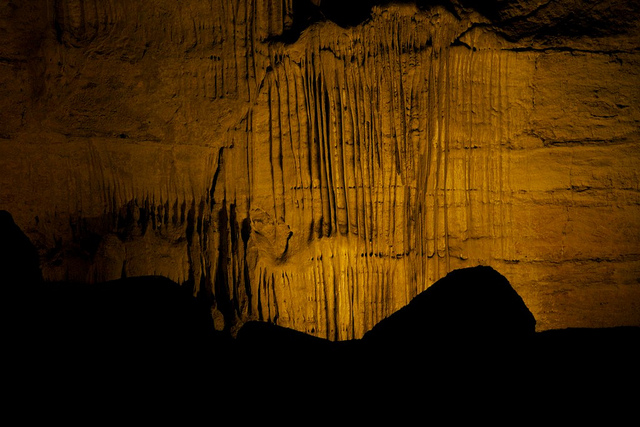
Flowstone can provide a detailed picture of historic climate conditions.
Evidence from caves in Siberia indicates that a global temperature increase of 1.5° Celsius may cause substantial thawing of a large tract of permanently frozen soil in Siberia. The thawing of this soil, known as permafrost, could have serious consequences for further changes in the climate.
Permafrost regions cover 24 percent of the land surface in the northern hemisphere, and they hold twice as much carbon as is currently present in the atmosphere. As the permafrost thaws, it turns from a carbon sink (meaning it accumulates and stores carbon) into a carbon source, releasing substantial amounts of carbon dioxide and methane into the atmosphere. Both of these gasses enhance the greenhouse effect.
By looking at how permafrost has responded to climate change in the past, we can gain a better understanding of climate change today. A team of international researchers looked at speleothems, such as stalagmites, stalactites, and flowstones. These are mineral deposits that are formed when water from snow or rain seeps into the caves. When conditions are too cold or too dry, speleothem growth ceases, since no water flows through the caves. As a result, speleothems provide a detailed history of periods when liquid water was available as well as an assessment of the relationship between global temperature and permafrost extent.
Using radioactive dating and data on growth from six Siberian caves, the researchers tracked the history of permafrost in Siberia for the past 450,000 years. The caves were located at varying latitudes, ranging from a boundary of continuous permafrost at 60 degrees North to the permafrost-free Gobi Desert.
In the northernmost cave, Lenskaya Ledyanaya, no speleothem growth has occurred since a particularly warm period around 400,000 years ago—the growth at that time suggests water was flowing in the area due to a melt in the permafrost. The extensive thawing at that time allows for an assessment of the warming required globally to cause a similar change in the permafrost boundary. Global temperatures at that time were only 1.5°C warmer than today, suggesting that we could be approaching a critical point at which the coldest permafrost regions would begin to thaw.
Not only will increasing global temperatures cause substantial thawing of permafrost, but it may also create wetter conditions in the Gobi Dessert, based on data from the southern-most cave obtained for the same time period. This suggests a dramatically changed environment in continental Asia.
Aside from changes in temperature and precipitation, thawing permafrost enables coastal erosion and the liquefaction of ground that was previously frozen. This poses a risk to the infrastructure of Siberia, including major oil and gas facilities.
No comments:
Post a Comment
Let us know your Thoughts and ideas!
Your comment will be deleted if you
Spam , Adv. Or use of bad language!
Try not to! And thank for visiting and for the comment
Keep visiting and spread and share our post !!
Sharing is a kind way of caring!! Thanks again!